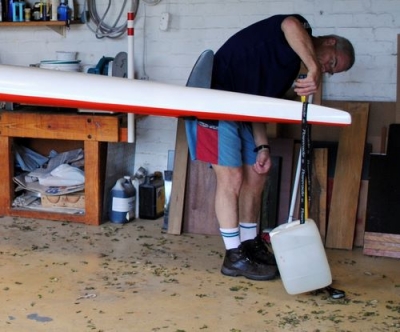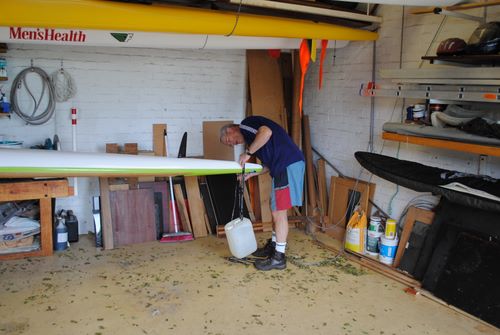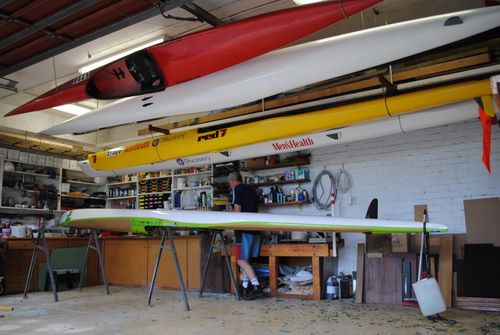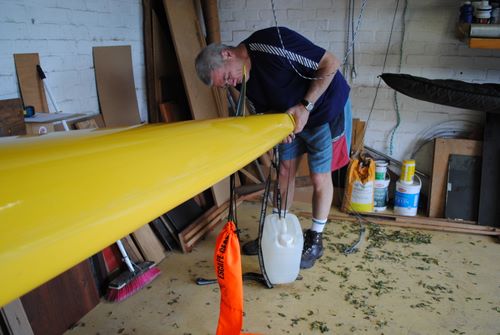Stiffness and Stability
 Measuring the hull stiffness of the carbon Red7
Measuring the hull stiffness of the carbon Red7
We had the unique opportunity to compare two identical skis - identical that is except for the layup. One is a stiff carbon ski; the other has a cork composite layup. How does the stiffness of the skis compare - and what difference does it make to the stability of the ski?
Red7 Surf70 Pro
I've been paddling the "Green7" - a Red7 Surf70 Pro built in a cork composite layup - for a couple of weeks now. I've found it a very user friendly, fast boat (weight 12.7kg).
My buddy Dale Lippstreu just took delivery of a carbon Pro. It was a relatively heavy example - 12.6kg - but, being made of carbon, is relatively stiff.
So we had two identically shaped boats of nearly identical weight. The only difference was the stiffness - so we were in a unique position to see how stiffness affects the feel of the boat.
Measuring the Green7
Hout Bay Chop
We took the boats out from Hout Bay. There was a light northwesterly blowing which would have little effect on us - but a sizeable swell was coming in and we knew that it would be rebounding off the cliffs at the base of the Sentinel - the peak that guards the entrance to the bay.
I paddled the cork Green7 first; Dale was on the stiff carbon ski.
As we went around the base of the Sentinel, Dale fell further and further back - and said that he found the carbon ski noticeably tippier than his own Red7 (one of the original single piece molded boats).
Roughly 2.5km from the harbor, we turned around and caught some runs back into the bay. Once again, Dale found the ski tippy.
Green7 in position
Adjusting the footplate
Back at the ramp we swapped skis. Dale paddles with a shorter leg length than me so we had to adjust the footplates and rudder pedals. The new boats have a 3-point secured footplate and although this makes the footplate one of the firmest, most secure that I've tried, I battled to adjust it. Eventually I managed though, and off I went in the carbon ski while Dale paddled the Green7.
Once again I left him behind on the way out. He confirmed that the Green boat felt significantly more stable - but claimed that the depression caused by South Africa's performance against Australia in the Rugby Tri-Nations had left him depleted of energy.
No doubt about it though - I also found the carbon boat perceptibly tippier and took several brace strokes in the chop under the Sentinel.
So much for that; the point is that we both agreed that the stiff carbon boat was definitely more twitchy than its cork composite cousin.
But how stiff is stiff?
Measuring the "yellow peril" - an original one-piece moulded glass Red7
The Lippstreu Stiffness Factor
We measured the stiffness of the skis using a simple test.
We placed the ski upside on a metal trestle positioned where the bucket is deepest. We then hung a 10l plastic container filled with water (i.e. a 10kg weight) on the tail of the ski, 2.8m from the trestle and measured the deflection.
Apart from the cork Green7 and the carbon Red7, we also measured Dale's old Red7 - this one was repaired after major damage and has about 1.5m of carbon inserted around the cockpit area. This has made it stiffer - but it's also heavier than the test boats.
Here are the results:
| Layup | Weight | Deflection | Tippiness |
|---|---|---|---|
| Glass/Carbon | 16.1kg | 17mm | Least |
| Cork composite | 12.6kg | 31mm | |
| Carbon | 12.7kg | 15mm | Most |
Conclusions
- Since the carbon and cork composite skis were practically identical except for stiffness, we can confirm the commonly held truth that stability is affected by the stiffness of the ski - at least with the Red7.
- (For me - I prefer the light but easier to paddle cork composite layup. I find the cork Green7 easy relatively stable; I find the carbon Red7 significantly more twitchy! I'd put the two skis' stability on either side of the carbon Fenn Mako Elite.)
- Dale's poor performance on the day was directly related to the performance of the Springboks in Brisbane i.e. a bit off the pace.
Note!
Note that neither of these skis represents the standard Red7:
- The production cork composite boats are slightly heavier (around 13.2kg) and stiffer; after extensive testing, they've added a layer of Kevlar to the mid-section of the boat to protect the areas most often stressed by tie-down straps.
- The production carbon boats are slightly lighter than our test boat.
The point of our test was to compare two identical-except-for-layup skis to correlate stability with stiffness.
More tests
We'll be repeating this test on other skis - and adding it to our future reviews of skis (I just took delivery of a "performance" V12. Paddled it today in a mild downwind and thoroughly enjoyed it but... Dale was faster than me on his V10 Elite... and that doesn't often happen! Look out for the V12 and Green7 reviews in a couple of week's time.)




